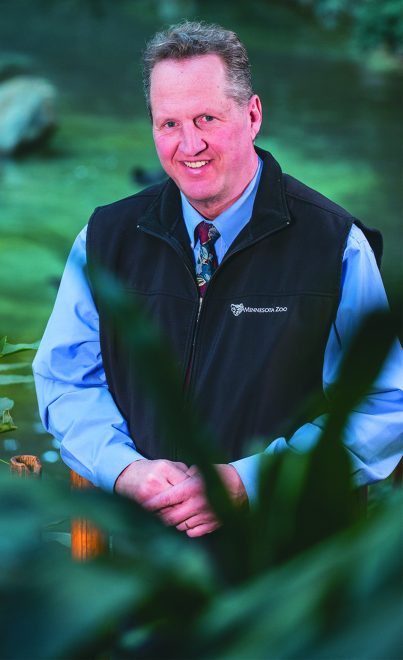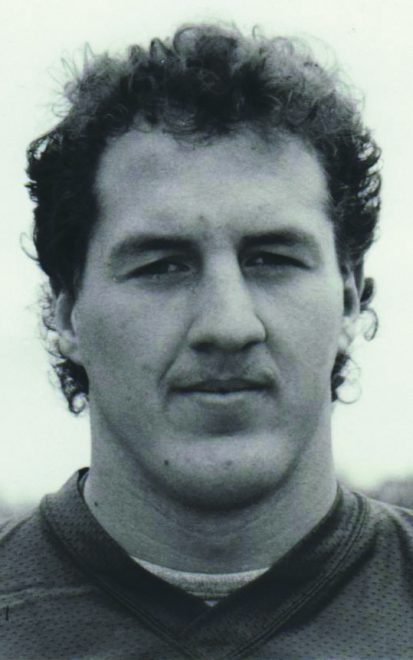Outside, it’s a typical February day in Minnesota. But here, on the Tropics Trail at the Minnesota Zoo in Apple Valley, it’s a balmy 75 degrees.
The zoo’s director, John Frawley, poses for photos in front of a pair of active white cheeked gibbons. In between snaps, he greets visitors and offers up some zoo facts:
With more than 500 acres, the Minnesota Zoo is home to 4,880 animals, 67 of which are on the threatened or endangered species list. Nearly 1.3 million visitors pass through the zoo’s gates each year, including almost 100,000 school children on field trips. Keeping it all afloat is a permanent staff of about 275, bolstered by an army of 1,200 dedicated volunteers.
Frawley says goodbye to the gibbons and makes his way back to the main exit, passing a variety of tropical species along the way.

MSU Alumni – John Frawley – President and Director of the Minnesota Zoo and Minnesota Zoo Foundation
“Everybody is just in the right position today,” he says, pointing to a gigantic Komodo monitor lounging lazily in full view of the winding trail. Next he calls out the ring-tailed lemurs— “Madagascar”—then pauses at the entrance when he notices finger smudges on one of the glass doors separating the Tropics Trail from the lobby.
He’ll get someone right on that.
Frawley is still fairly new to the director position. He took the job in 2016 after two decades as President and CEO of Aquarium of the Bay in San Francisco. Thus far, he’s playing to his strengths, focusing on conservation, education and accessibility.
Back on his home turf
Frawley enjoyed his years in San Francisco, but he frequently jokes that he left his heart in Minnesota. Growing up, first in Stillwater then in Red Wing, Frawley nurtured two passions: sports and the outdoors. During his college years, he had a chance to dive deep into both.
In 1982, Frawley was accepted to Minnesota State Mankato on a football scholarship. He was a defensive end and part of the 1987 Hall of Fame team led by coach Dan Runkle. His former teammate and defensive coordinator, Dave Schlichte ’85 remembers Frawley as a driven athlete and a dedicated teammate.

Frawley in his Maverick football days.
“John was one of those guys who worked tremendously hard and has exceptional motor,” he says. “[He’s a] guy that was just going to play hard and do what he was supposed to do to be a very good player.”
The two former teammates had kept in touch a little bit over the years, so when Schlichte read an article about Frawley returning to Minnesota to head up the zoo, he reached out. They met up at the zoo, and Schlichte discovered little had changed.
“John’s got a certain personality and a certain openness and warmth to him,” he says. “He had that as an 18-year-old, and I think he conveys that message extremely well. But, he’s got his foot on the pedal and he wants things to happen and get done, and he understands how to try to get it done in a good, positive manner.”
The two had a good time catching up, and the meeting led to a partnership. Schlichte, vice president for The Creative Company in Mankato, and Frawley are now working together on a book project that will highlight the plight of turtles in the wild.
It’s not the only Maverick connection that Frawley has brokered since returning to Minnesota.
“One of the early things I did was reach out to President [Richard] Davenport for a meeting,” he says. “What came out of that were a lot of ideas of how we could partner and help deliver better to our missions. … Continuing that relationship with the school, but also connecting people to nature and animals.”
Minnesota State Mankato currently has two events planned in partnership with the zoo: An adults-only evening on May 11 and a Maverick Family Day on August 19.
Conservation and connections
Football drew Frawley to Minnesota State Mankato, but it was digging deep into his second passion—the outdoors—that opened up the possibility for a career doing what he loves.
“I thoroughly enjoyed a whole sports career at Mankato, but the real surprise was that I was exposed to Recreation, Parks and Leisure Services, which I didn’t see coming,” he says. “Sports brought me there, but I left Mankato with the foundation I built my whole career on.”
After graduating with a degree in Recreation, Parks and Leisure Services with a concentration in Wildlife Management, Frawley worked as a zookeeper, first in Texas, then at the Minnesota Zoo. He moved out West and spent the bulk of his career—the better part of two decades—developing conservation initiatives for the marine life and ecosystem in the San Francisco Bay.
His environmental focus made him a perfect fit for the Minnesota Zoo, an organization deeply committed to protecting and caring for endangered species within its own walls and in the wild.
“The big thing I learned in conservation is that there’s a big literacy problem,” he says. “One of the things we want to focus on in our industry is to address a real strong environmental education approach to educate people about these critical issues. That’s a piece of conservation that’s becoming more and more important. Connecting people to nature is the first step in conservation.”
To make those connections, he notes, people need to be able to experience wildlife—and the zoo is a great place to start.
“That’s why our new strategic direction is to really focus on connecting people to the natural world. … Before we get to [saving] wildlife, we need to do that connection.”
Critical to that connection, Frawley has found, is access.
Access for all
In 2016, the Minnesota Zoo launched an innovative initiative called Free to Explore that allows any Minnesota family or individual receiving general assistance, like SNAP benefits or WIC, to come to the zoo for free, any day of the week.
“We want people to have great family experiences, but some families don’t have the means,” he says. “The state of Minnesota does a great job identifying general assistance needs. We [align] with those state programs and tell our guests that if you qualify for general assistance with the state of Minnesota, just show your card like it’s a membership card at our front door, and we will let you and your family in for free.”
Zoo traffic increased by about 200 percent almost immediately after the program launched and has continued to grow steadily by about 60 percent each month. The zoo is on track to welcome 100,000 Free to Explore visitors in 2018.
Frawley’s next task is to partner with corporations to make the zoo even more accessible, especially for families who do not qualify for general assistance but may not have a day out at the zoo in the budget. Recently, Dakota Electric underwrote an outing where customers were invited to bring their electric bills as a pass to get into the zoo free for the day.
And while about 66 percent of Minnesotans are within an hour’s drive of the zoo, it’s not an easy jaunt for many. That’s why Frawley is focused on making it easier for all Minnesotans to experience the zoo—either on its campus or in their own back yards.
“Greater Minnesota is a big focus for me,” he says. “There are so many great programs going on all over the state that we need to just open up our door wide … through education, conservation partnerships, access or diversity or inclusion.”
The Zoomobile is one way the zoo is reaching out to greater Minnesota, visiting libraries, schools and senior centers. Another way is through partnerships with institutions that bring groups of students from all over the state to the zoo.
As Frawley moves forward in his role, he hopes to open the door to more partnerships and big ideas that allow even greater access to the place he now calls home. “That’s our job as the state zoo, to keep taking away those barriers and keep making access a priority,” he says. “I want the zoo to get into the fabric of Minnesota.”
Sarah Asp Olson
Speak Your Mind